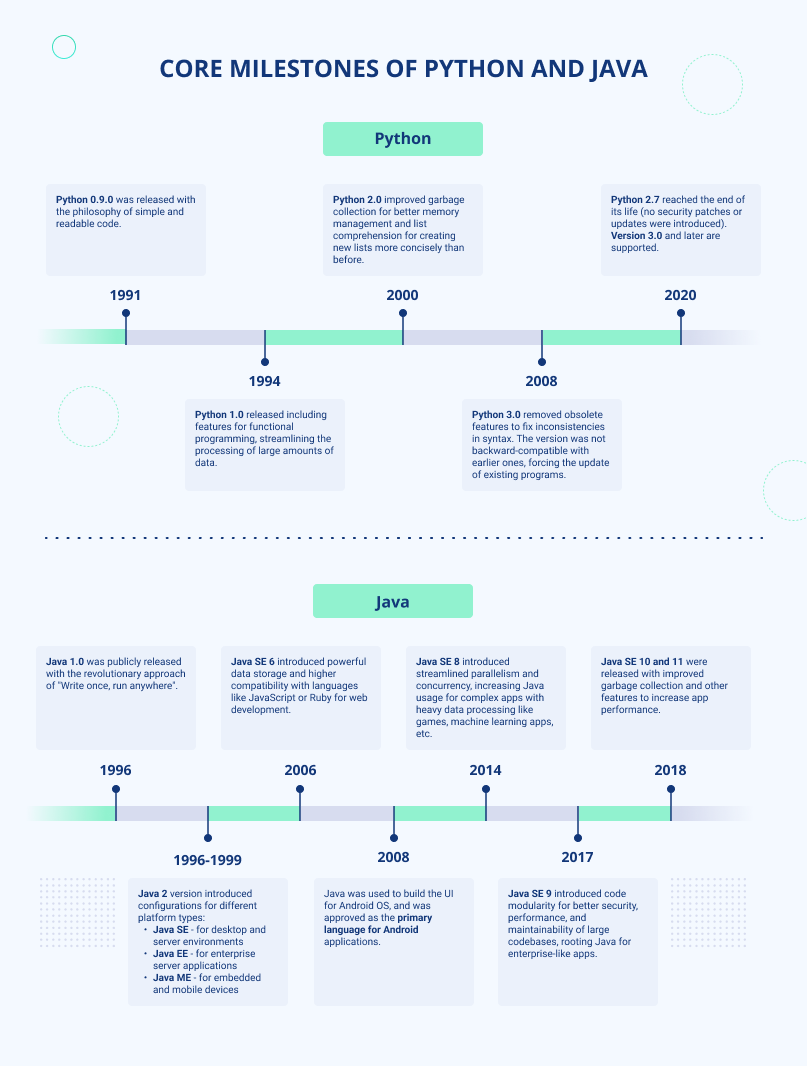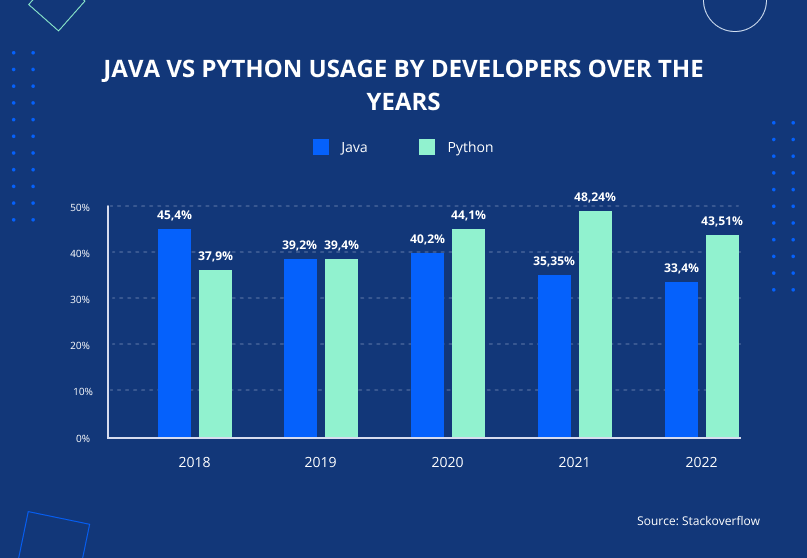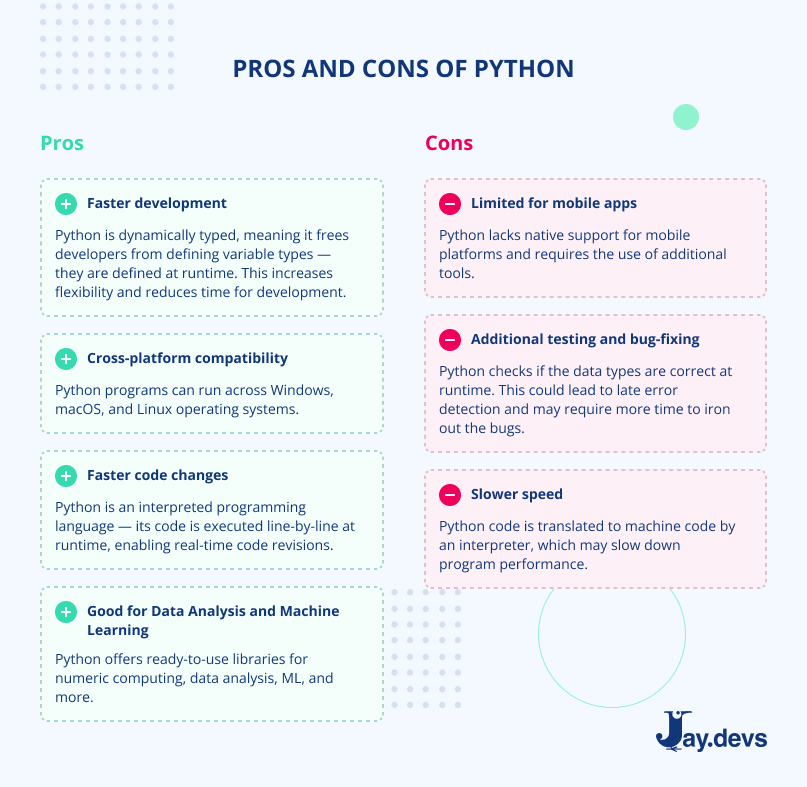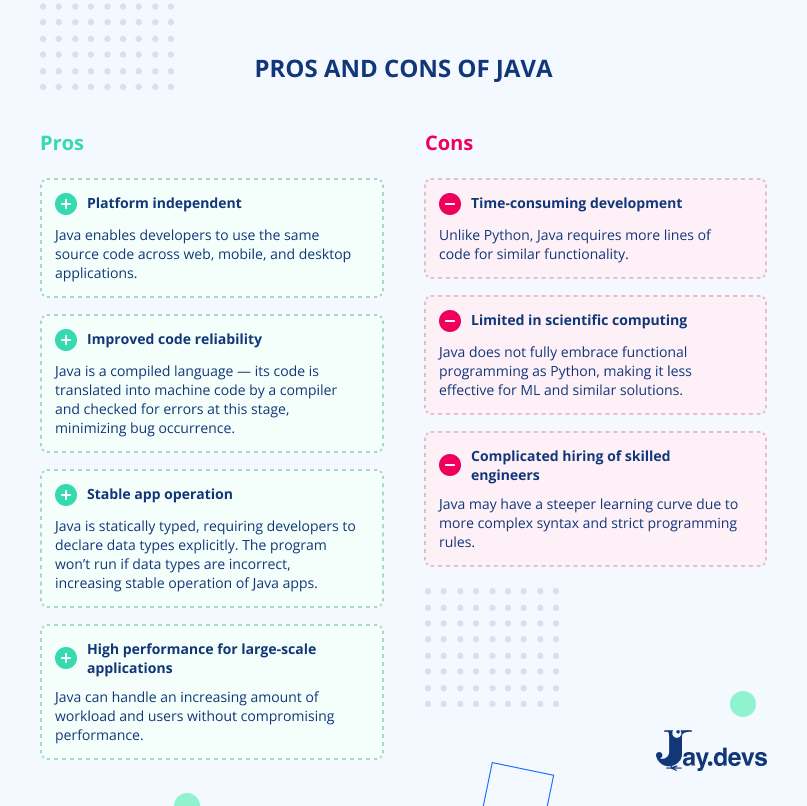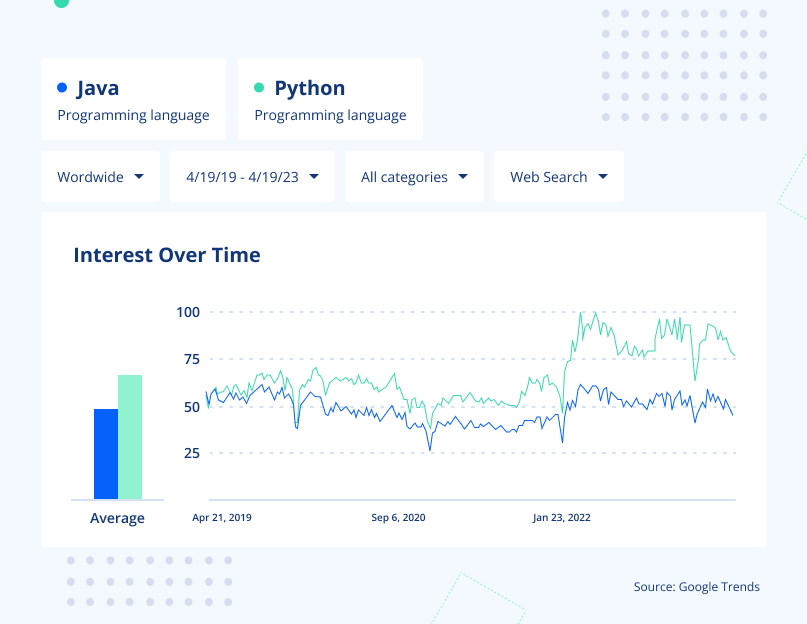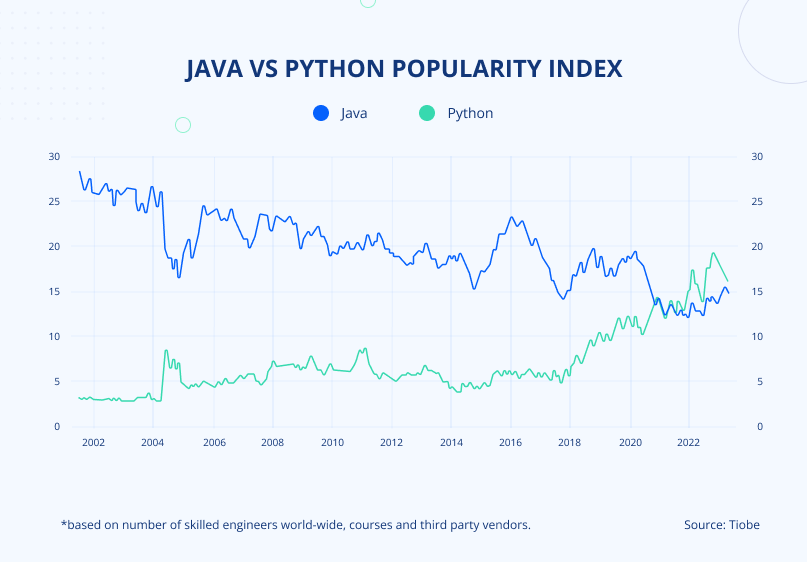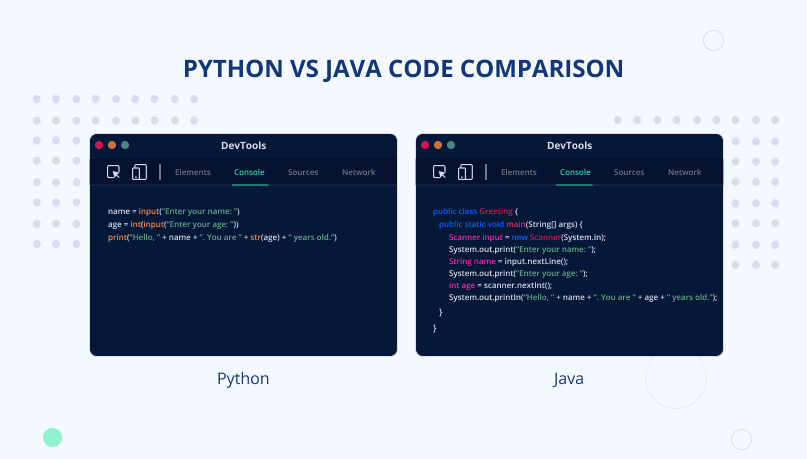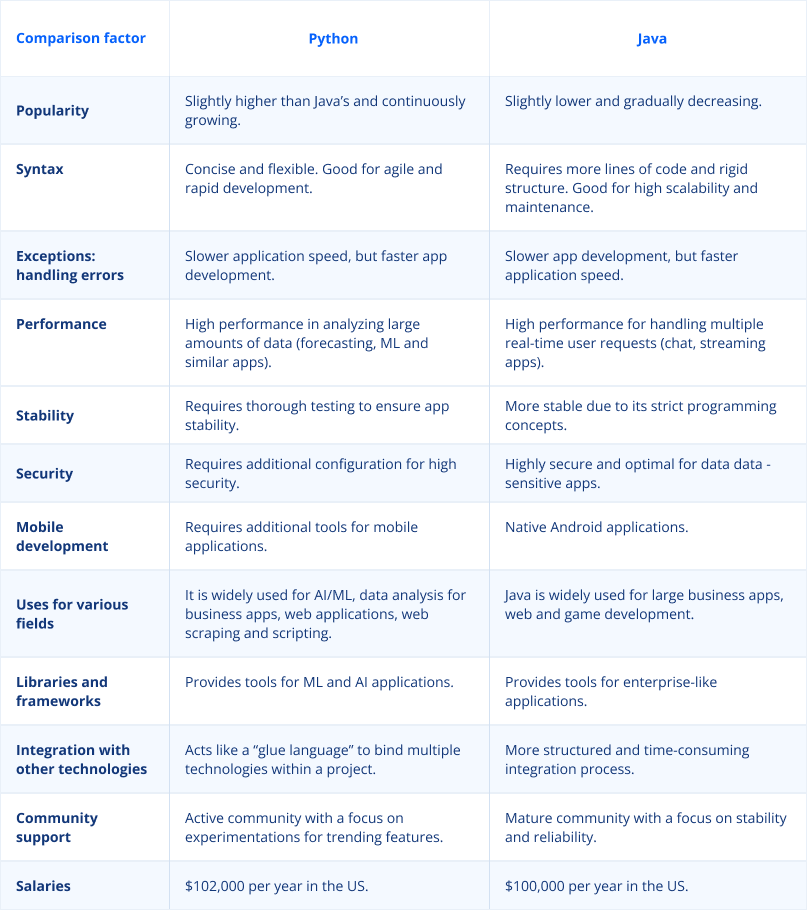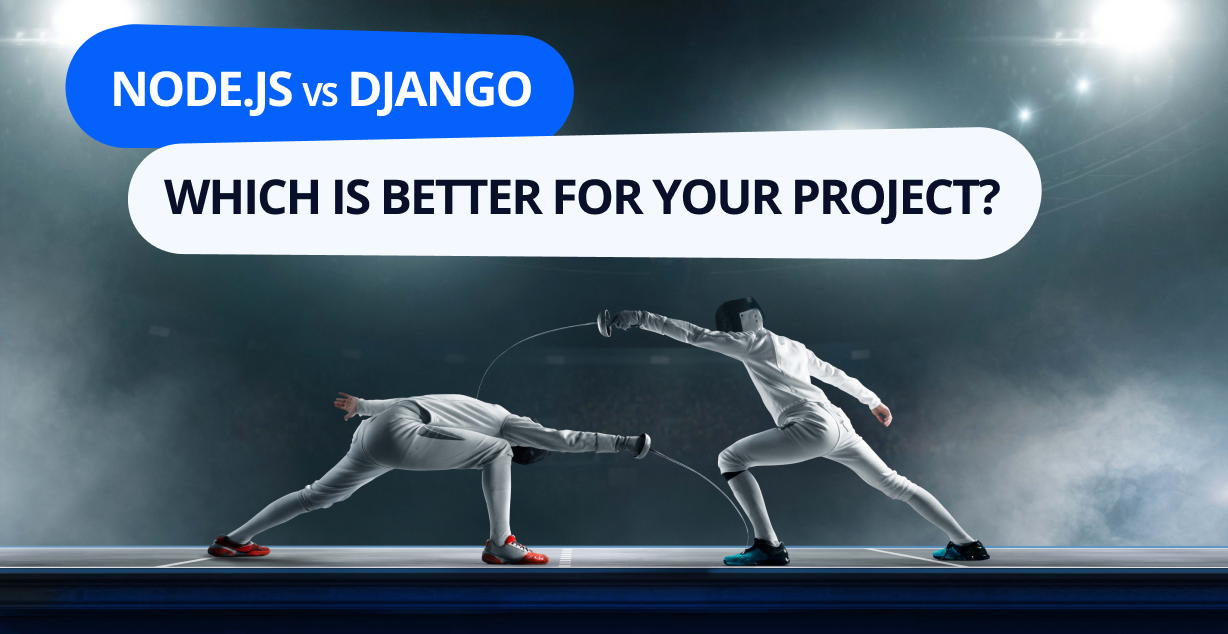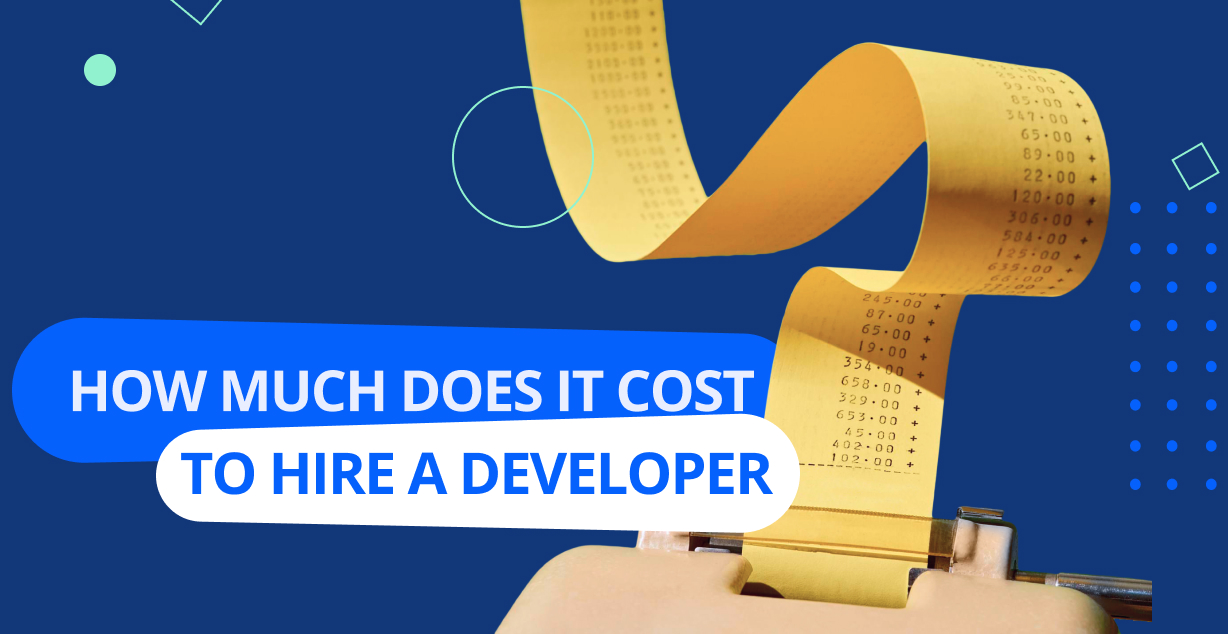Java and Python are the most popular programming languages used by businesses worldwide. So, choosing between them can be daunting, as both tools have similarities and intersecting use cases.
The following article will provide you with an in-depth comparison of Java vs Python, their pros and cons, and principal differences. Having this head-to-head analysis may help you choose the most effective tool for your specific business case.
Python vs Java: Introduction
Both technologies are general-purpose languages, meaning that they are used for various applications and industries. Comparing their history and popularity may be a good starting point for understanding what is the difference between Java and Python.
Brief History of Python and Java
Python programming language was developed by Guido van Rossum in 1991. Python prioritizes code readability and simplicity, making it a popular choice for rapid development.
In contrast, the Java programming language was created by James Gosling at Sun Microsystems in 1995 as a robust and portable language. It became widely used due to its platform independence, allowing the creation of cross-platform software.
Both programming languages are far from their initial releases and are still in progress. Here are the core milestones of how they evolved over time:
Comparison of Python and Java in Terms of Popularity
One way to measure the popularity of programming languages is to discover how many developers use each. The more technology is used, the wider the talent pool is, and the more innovation you can access for your project.
Comparing Python vs Java in StackOverflow surveys demonstrates how 43.51% of professional developers reported using Python regularly in 2022, while Java was used by 33.4% of programmers.
The 5-year comparison of Java and Python’s difference in usage reveals Python as a growing language and Java — as a declining one:
Python vs Java: Pros and Cons
Defining Python vs. Java in terms of their unique strengths and weaknesses may help in choosing the best tool for your needs.
Advantages of Using Python
In the Java vs. Python comparison, the latter stands out with the following pros:
- Faster development: Python is a dynamically typed language, meaning it frees developers from defining variable types as they are defined at runtime. This increases flexibility and reduces the time for development.
- Cross-platform compatibility: Python programs can run across Windows, macOS, and Linux operating systems.
- Faster code changes: Python is an interpreted programming language; its code is executed line-by-line at runtime, enabling real-time code revisions.
- Good for Data Analysis and Machine Learning applications: Python offers ready-to-use libraries for numeric computing, data analysis, ML, and more.
Disadvantages of Using Python
The notable limitations of Python compared to Java are as follows:
- Limited for mobile apps: Python lacks native support for mobile platforms and requires the use of additional tools.
- Additional testing and bug-fixing: Python checks if the data types are correct at runtime; this could lead to late error detection and may require more time to iron out the bugs.
- Slower speed: Python code is translated to machine code by an interpreter, which may slow down program performance.
Advantages of Using Java
By comparing Java versus Python’s unique features, Java stands out with the following advantages:
- Platform independent: Java enables developers to use the same source code across web, mobile, and desktop applications.
- Improved code reliability: Java is a compiled language; its code is translated into machine code by a compiler, and errors are checked for at this stage, thereby minimizing bug occurrence.
- Stable app operation: Java is statically typed, requiring developers to declare data types explicitly. In other words, the program won’t run if data types are incorrect, thus increasing the stable operation of Java programs.
- High performance for large-scale applications: Java can handle an increasing amount of workload and users without compromising performance.
Disadvantages of Using Java
On the downside, Java is limited by:
- Time-consuming development: Unlike Python, Java requires more lines of code for similar functionality.
- Limited in scientific computing: Java does not fully embrace functional programming as Python, making it less effective for ML and similar solutions.
- Complicated hiring of skilled engineers: Java may have a steeper learning curve due to more complex syntax and strict programming rules.
Python and Java Trends in 2024
The Java vs Python differences reveal how both technologies develop with a focus on distinct areas. As a result, reviewing the market trends for Python or Java in 2024 may help you gain insight into what technology may be more effective for your business.
Current Market Trends for Python and Java
According to an annual report by JetBrains, both technologies are similarly used for web and infrastructure development:
Nonetheless, when comparing Python vs Java for web development, JetBrains reports a “downtrend in the usage of Python.” On the flip side, Java is increasingly used for websites and web apps.
Regarding Python vs Java desktop application development, Python is in the lead. It is also utilized more for Cloud platforms and IoT.
For the bigger picture of Python versus Java market trends, JetBrains reports that Python is mainly used for Data Analysis and Machine Learning. At the same time, Java usage lies in web and system software.
Future Predictions for Python and Java
Both technologies are expected to remain popular languages for software development.
As more businesses adopt AI and ML technologies, Python’s popularity is expected to grow, while Java will remain a top choice for enterprise-level applications because of its stability and reliability.
According to Python vs Java Google Trends, the interest in such technologies is consistently increasing, with Python slightly overtaking Java since 2019:
Java vs Python: Overview of the Latest Updates and Features
Recent updates may help to determine their suitability for specific programming tasks.
The latest Java updates brought virtual threads and structured concurrency features. Both aim to simplify development and troubleshooting in applications with multiple real-time operations, for instance, streaming or trading platforms.
The latest Python version includes increased program execution speed and improved error reporting. This may enhance performance and data accuracy for image and text processing solutions.
Key Differences Between Python and Java
We’ve looked through the basics and market trends. Now, the head-to-head comparison of Python vs Java key differences may help strengthen your understanding of what each technology can offer for different projects.
#1. Popularity
Both Java and Python are among the top-used languages, regardless of the source.
According to the recent TIOBE popularity report, Python is the most popular programming language with a 14.51% market share, while Java ranks third with a 13.73% market share. In the bigger picture, Python has been gaining more popularity over Java since 2020:
Python pulled ahead, meaning it is more googled and used by developers worldwide. So, can Python replace Java? No, as they have different strengths and are used for different purposes, which we’ll discuss further.
#2. Syntax
The comparison of Python and Java differences in syntax can provide insight into what technology is more flexible for development.
Python’s dynamic typing allows for omitting data types for more concise code. Additionally, Python supports four main programming paradigms: imperative, functional, procedural, and object-oriented. These features enable more flexible and faster implementation.
Java is a class-based, strongly and statically typed object-oriented programming language, requiring developers to structure their code into objects and additional code to write. This may increase development time but provides a well-structured and maintainable codebase for expanding projects.
Here are code examples of Python vs Java:
Java and Python differences in syntax demonstrate how Python is fitted for agile and rapid development while Java is more rigid and good for projects requiring better scalability and maintenance.
#3. Speed
To compare Python vs Java runtime speed, it’s important to recall the tech peculiarities of each.
Python is an interpreted language, meaning the Python’s interpreter reads and executes code line by line at runtime. This results in faster development times but can lead to slower app speed due to repeated interpretation processes.
In contrast, Java code is compiled beforehand and executed by Java Virtual Machine quickly. The code compilation may lead to longer application launch times but results in higher speed.
Each technology brings distinct benefits: Python will provide you with faster time-to-market, while Java will provide faster app speed.
#4. Performance
A multithreading feature is often used for high performance, enabling programs to do multiple tasks at once. However, Java and Python have different performance optimization features.
By comparing Python vs Java multithreading capabilities, it is clear that Python is limited to running a single thread at a time but offers multiprocessing effective for analyzing large amounts of data. This is valuable for heavy computing used in AI and ML apps.
Python vs Java performance benchmark shows how Java provides great multithreading capabilities and performs better when handling multiple user requests simultaneously (e.g., authorization). This makes Java efficient for responsive solutions with an instantly growing user base.
Java and Python can be highly performant for different tasks: Python is perfect for complex computations (forecasting, ML, AI, and similar apps); Java is good for applications with multiple real-time user requests (chat and streaming apps).
#5. Stability
Both programming languages are stable in their core due to regular updates. Yet, the comparison of programming concepts may show what technology provides more app stability.
The dynamic nature of Python may lead to runtime errors. This means that Python program may require extra testing.
Java is based on strict programming concepts. Despite Java being more time-consuming, it ensures the compiled code is error-checked before running, bringing more stable applications.
When choosing the optimal tool, consider the following: Python requires a thorough QA phase to ensure app stability, while Java is more time-consuming but highly stable for apps.
#6. Security
Security may affect both project timeline and app safety.
Python is less secure: its dynamic nature may pose security risks, requiring additional manual configuration to prevent injection attacks.
In contrast, Java is secure de facto as it provides advanced built-in features like access control and authentication that help prevent malicious code from running.
Thus, Python requires extra configuration, while Java is more secure and optimal for data-sensitive apps (such as banking and government).
#7. Mobile App Development
The core difference lies in the fact that Python doesn’t support mobile operating systems natively.
Whether it be iOS or Android, developers should use additional frameworks to build an app with Python. This may require additional time and experience to deliver rich user experiences.
In contrast, Java is an official Android language. Android SDK comes with lots of standard Java libraries that streamline mobile development.
Regarding Android development with Python vs Java, the latter is the clear winner. You can also leverage Python, making sure your team is experienced in corresponding frameworks.
#8. Uses and Applications in Various Fields
The core peculiarities of these object-oriented languages make them fit for different fields. Here is a brief overview of Python vs Java usage:
- Artificial intelligence/Machine Learning: Python is simple and frees time for developers to create machine learning algorithms, while the multiprocessing feature helps in analyzing large data volumes. Java can also be used for similar solutions, yet it requires more time and budget.
- Games: Java is more powerful due to its game engines, high performance, and native Android support. Python is widely used for game scripting to control certain aspects of the game.
- Business applications: Java is more stable, scalable, and widely used for ERP systems. Python, with its brevity, is better for data analysis or task automation services to use in business apps, e.g., generating reports.
- Web development: Java is solid for developing enterprise web systems, while Python is especially good for web scraping and scripting.
#9. Industry-specific Comparison
The list of Python vs Java use cases is vast and intersecting. Listed below are the core industries where these technologies are used the most.
#10. Third-party Libraries and Frameworks
Both tools have a wide range of libraries and frameworks that help speed up the development of certain projects.
Python has various ML and data analysis tools, such as NumPy and TensorFlow. It also offers Django and Flask frameworks for web development.
Java provides a Spring web development framework and diverse libraries for performing tasks common in enterprise apps (e.g., Drools for business rule engine and Hadoop for BigData).
That’s why businesses usually prefer Java when choosing between Python vs Java for enterprise application development.
#11. Integration with Other Technologies
Integration features allow for using new technology in a project without any hassle.
Python can be used along with Java, C/C++, Go, and more. It often acts as “a glue language” that binds technologies together with minimum code. This may be beneficial for microservice solutions: developers can easily integrate new Python system modules.
Java may require more time to integrate with other technologies. However, its structured integration approach provides more security and stability especially important for business applications.
Comparing Java full stack vs Python full stack capacities, both tools integrate with front-end technologies such as React and Angular.
#12. Community Support
Strong community support can be a helping hand in improving Python vs Java efficiency in projects.
Python has an active community focused on open-source development and experimentation, releasing new software tools. This may simplify and accelerate the implementation of innovations.
Java has a mature tech community focused on maintaining language standards, with large organizations backing its development. This makes Java a highly reliable technology.
Thus, Python may help speed up the implementation of trendy features, making your product outstanding. Java, in contrast, provides high reliability for mission-critical solutions.
#13. Developer Salary
The demand for Python vs Java programming languages is relatively the same, which is reflected in developer salaries.
According to Glassdoor, the average salary for in-house Python developers in the US is about $102,000/year, while the average salary for Java developers is about $100,000/year.
To assemble the team of top engineers, you can leverage our ultimate hiring guide, including Python vs Java interview questions and more.
Python vs Java: Comparison Table
The table below is a quick guide to navigating the difference between Python and Java:
Choosing Between Python and Java for Your Project in 2024
In this article, we’ve dove deep into the core differences between Java and Python. Let’s analyze their advantageous usage scenarios to determine the best fit for your business needs.
For businesses seeking to augment their IT teams or recruit tech talent, Python emerges as an ideal choice due to its versatility and suitability for various tasks:
- Agile development and fast time-to-market (MVP, proof of concept, and similar solutions),
- Systems built with multiple languages that require easy integration of new modules (microservice applications),
- Web applications using Django and Flask frameworks,
- Computer science, scientific and numeric computing (Data Science, ML, AI),
- Solutions requiring high data accuracy (image/text processing, algorithms),
- Data analysis and task automation services (generating reports, data visualizations).
Conversely, Java offers distinct advantages in scenarios where stability and scalability are paramount:
- Projects focused on app speed and stability (enterprise, eCommerce, trading systems),
- Streamlined app scalability and maintenance (CRM, ERP systems),
- Real-time applications with a growing user base (chat, streaming apps),
- Highly secure systems (financial, governmental solutions),
- Large-scale web solutions,
- Desktop GUI apps,
- Game development,
- Native Android applications.
Conclusion
JayDevs specializes in providing businesses with remote, vetted engineers proficient in Python and Java on a contractual basis. Whether you require one developer or a complete team, we offer talent tech recruiting and IT staff augmentation services tailored to your needs.
If you lack talents for AI and ML app development or data analysis modules for web solutions, you can hire Python developers remotely with JayDevs.Similarly, if you require skilled developers for your large-scale Java project or native Android application, you can hire Java developers in no time. Contact us for more details!






